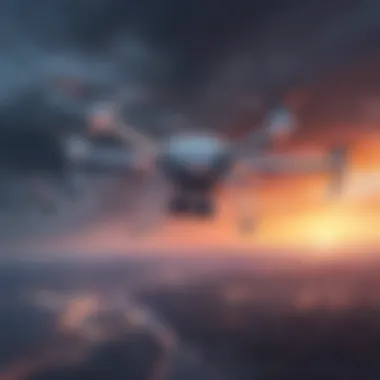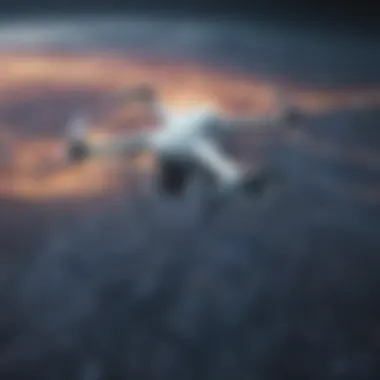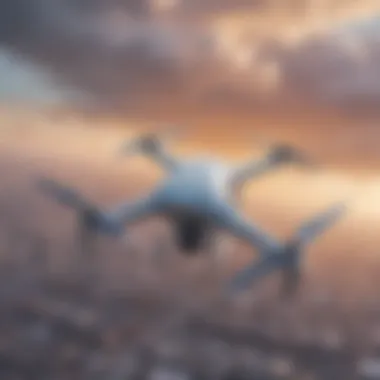Unveiling the Impact of Drones on Meteorological Data Collection in Weather Monitoring


Tech Trend Analysis
Drones impact the advancement in weather monitoring by providing real-time insights with exceptional precision using cutting-edge technology. The current trend sees a significant increase in the use of drones for meteorological data collection. Meteorologists benefit from enhanced data accuracy and the ability to access hard-to-reach areas for comprehensive weather analysis. This trend indicates a notable shift towards more efficient and detailed weather forecasting, promising improved forecasting accuracy and early warning systems for severe weather events.
Product Reviews
Drone for Weather Monitoring
The drone designed for weather monitoring is a sophisticated technological marvel equipped with state-of-the-art features to capture meteorological data. With a lightweight yet durable build, these drones can withstand varying weather conditions, ensuring consistent performance. Boasting high-resolution cameras and specialized sensors, these drones offer unparalleled data collection capability. However, challenges such as battery life and operational range need to be addressed to optimize their efficiency further. Overall, the drone for weather monitoring presents a remarkable tool for meteorologists to revolutionize weather data collection.
Features and Specifications
The drone for weather monitoring is equipped with high-definition cameras, multispectral imaging capabilities, GPS navigation systems, and advanced meteorological sensors. These features enable precise data collection while ensuring the drone's stability and accuracy during flights. With extended flight times and advanced battery management systems, these drones can cover vast areas for comprehensive data gathering.
Performance Analysis
The performance of weather monitoring drones is commendable, providing real-time data acquisition in areas that are challenging for traditional methods to access. These drones offer on-demand weather information, facilitating quick response to changing weather conditions. However, optimizing flight paths and data processing efficiency remains crucial for maximizing their performance in meteorological applications.
Pros and Cons
Pros
- Real-time data collection
- Enhanced data accuracy
- Improved weather forecasting
Cons
- Limited battery life
- Restricted operational range
- Data processing challenges
Recommendation


For meteorologists and weather monitoring agencies, investing in weather-specific drones presents a valuable opportunity to enhance data collection capabilities and improve forecasting accuracy. While addressing battery life and operational range limitations, leveraging the advanced features of weather monitoring drones can significantly elevate meteorological data analysis and predictions.
Introduction
Taking a closer look into the profound impact of drones on weather monitoring unveils a compelling narrative at the crossroads of technology and meteorology. This article delves into the intricacies of how drones have reshaped the landscape of meteorological data collection. By leveraging the agility and versatility of drones, meteorologists now have unprecedented access to real-time, pinpoint accurate weather information, offering invaluable insights into weather patterns and atmospheric phenomena. The fusion of advanced technology with the age-old practice of weather monitoring has opened new frontiers in enhancing our understanding of the ever-changing climate dynamics.
Understanding the Evolution of Weather Monitoring
Historical Methods of Weather Observation
Exploring the annals of weather monitoring reveals a fascinating journey marked by traditional methods of observation. From relying on human observers to rudimentary instruments like rain gauges and anemometers, historical methods of weather observation laid the foundation for our current understanding of meteorology. The charm of these classic techniques lies in their simplicity yet effectiveness in capturing crucial data points essential for forecasting. While these methods may lack the finesse of modern technology, their historical significance in shaping meteorology cannot be understated.
Emergence of Technological Advancements in Meteorology
The dawn of technological advancements in meteorology heralded a new era of precision and accuracy in forecasting. Innovations like weather satellites, radar systems, and computer modeling revolutionized how we gather and interpret weather data. The seamless integration of these cutting-edge technologies has vastly improved forecasting capabilities, enabling meteorologists to predict weather patterns with unprecedented detail and lead time. However, with these advancements come challenges such as data interpretation and model calibration, underscoring the complexity of modern meteorological practices.
Significance of Accurate Weather Data
Impact on Agriculture and Farming
Accurate weather data plays a pivotal role in the agricultural sector, shaping decisions around planting, irrigation, and crop management. By providing farmers with timely information on weather patterns, drones contribute to maximizing crop yields, minimizing water usage, and mitigating climate risks. The relevance of drones in agriculture lies in their ability to offer on-demand, hyper-local weather insights, empowering farmers to make informed choices for optimal agricultural productivity.
Role in Disaster Preparedness
In the realm of disaster preparedness, reliable weather data is instrumental in forecasting and mitigating natural calamities. Drones equipped with state-of-the-art sensors are deployed in disaster-prone areas to monitor weather conditions and provide early warnings for impending disasters. The proactive use of drones in disaster preparedness enhances response strategies, minimizes casualties, and ensures efficient evacuation procedures. However, regulatory frameworks and privacy concerns pose challenges in the seamless integration of drones into disaster response protocols.
The Advent of Drone Technology
In this section, we delve into the critical role of drone technology in revolutionizing weather monitoring. Drones, also known as Unmanned Aerial Vehicles (UAVs), have presented a paradigm shift in meteorological data collection. Through their ability to swiftly navigate challenging terrains and reach remote locations, drones enhance the accessibility and mobility of weather monitoring systems. This advancement allows meteorologists to gather real-time data in areas previously deemed inaccessible, leading to a significant improvement in the accuracy and timeliness of weather forecasts.


Unleashing the Potential of Drones
Enhanced Mobility and Accessibility:
The enhanced mobility and accessibility capabilities of drones play a pivotal role in expanding the horizons of weather monitoring. By maneuvering through intricate weather systems and varying elevations, drones can capture data that would have been otherwise unattainable through traditional methods. Their agile movements and versatility enable meteorologists to collect information from diverse geographical regions, contributing to a more comprehensive understanding of weather patterns and phenomena. The adaptability of drones in traversing terrains that are hard to access by conventional means empowers meteorological research and enhances the efficiency of monitoring severe weather events.
Integration of Advanced Sensors:
The integration of advanced sensors in drones amplifies their data collection capacities, elevating the quality and depth of meteorological insights. These sensors, equipped with cutting-edge technologies such as Li DAR and infrared imaging, enable drones to capture detailed atmospheric data with precision. By utilizing advanced sensors, meteorologists can gather a wealth of information on temperature fluctuations, humidity levels, and air pressure variations. This integration not only enhances the accuracy of weather monitoring but also facilitates the identification of subtle weather changes that may have significant implications on forecasting models.
Regulatory Framework and Challenges
Navigating Airspace Regulations:
Navigating airspace regulations is a critical aspect that influences the deployment and operation of drones in weather monitoring activities. Compliance with aviation regulations and standards is imperative to ensure the safe and responsible use of drones in meteorological research. Understanding airspace restrictions, flight protocols, and collision avoidance measures is essential to prevent potential conflicts and hazards during data collection missions. Adhering to established regulatory frameworks fosters operational transparency and promotes the ethical use of drones in the pursuit of advancing weather monitoring capabilities.
Mitigating Privacy Concerns:
Mitigating privacy concerns surrounding drone operations is a paramount consideration in weather monitoring endeavors. The use of drones equipped with high-resolution cameras and geospatial tracking technologies raises apprehensions regarding data privacy and surveillance. Implementing privacy protection measures, such as data encryption, anonymization techniques, and geofencing capabilities, is crucial to safeguarding sensitive information collected during meteorological missions. Addressing privacy concerns not only ensures the ethical conduct of drone-based observations but also fosters public trust and acceptance of drones as integral tools in weather monitoring applications.
Revolutionizing Weather Monitoring
Weather monitoring has undergone a significant transformation with the integration of drone technology. This section dives deep into the essence of revolutionizing weather monitoring, emphasizing the crucial role it plays within the broader context of meteorology. By leveraging drones, meteorologists can access real-time data that offers unparalleled precision and accuracy, revolutionizing the way weather patterns and phenomena are observed and analyzed. The benefits of this advancement are multifaceted, ranging from improved forecasting capabilities to better disaster preparedness strategies. However, alongside these advantages come considerations such as navigating regulatory frameworks and addressing privacy concerns to ensure the ethical and responsible use of drone technology in weather monitoring.
Real-time Data Collection
Precision and Accuracy of Meteorological Readings
Precision and accuracy are pivotal in meteorological readings, and drones excel in providing real-time data with exceptional detail and reliability. The precision of these readings enables meteorologists to capture nuanced changes in weather patterns, enhancing the overall quality of meteorological data collection. By leveraging advanced sensors and sophisticated technology, drones can offer insights that were previously unattainable, resulting in more accurate weather forecasts and predictions. While the benefits of precise data collection are undeniable, challenges such as calibration errors and environmental interferences must be navigated to ensure the reliability of the information gathered.


Enhanced Predictive Capabilities
Enhancing predictive capabilities through drone technology is a game-changer in weather monitoring. Drones have the ability to gather data from challenging or inaccessible locations, providing meteorologists with a more comprehensive understanding of atmospheric conditions. This enhanced data collection empowers meteorologists to build more robust forecast models, improving the accuracy of weather predictions and early warning systems for severe weather events. The unique feature of enhanced predictive capabilities lies in the agility and adaptability of drones to capture data in real-time, offering a dynamic and responsive approach to meteorological analysis. However, challenges related to data processing and integration may arise, requiring meticulous attention to data management and analysis strategies to fully realize the potential of enhanced predictive capabilities.
Applications in Weather Forecasting
Improving Forecast Models
Improving forecast models using drone technology enhances the efficacy of weather forecasting by incorporating real-time data insights. The capability of drones to capture data from complex atmospheric conditions enables meteorologists to tailor their forecast models with a higher degree of precision. This leads to more accurate and timely weather forecasts, benefiting various sectors such as agriculture, transportation, and emergency response planning. The unique feature of improving forecast models with drones lies in the ability to capture micro-level weather phenomena, contributing to a more localized and detailed forecast. Despite these advantages, ensuring data uniformity and model calibration poses challenges that require continuous refinement and validation to bolster the reliability of forecast models.
Monitoring Severe Weather Events
Monitoring severe weather events through drone technology presents a proactive approach to disaster management and response. Drones equipped with specialized sensors can monitor and track severe weather conditions in real-time, providing invaluable insights for predicting and mitigating potential risks. The key characteristic of monitoring severe weather events with drones is the ability to capture dynamic weather patterns with high resolution, allowing for timely alerts and interventions in high-risk situations. While the advantages of enhanced monitoring are evident in improving response times and risk assessment, factors such as battery life limitations and weather constraints must be carefully managed to ensure uninterrupted surveillance during critical weather events.
Implications and Future Prospects
In the realm of weather monitoring, the implications and future prospects hold significant value. The integration of drone technology has paved the way for advancements in climate research and environmental monitoring. One key aspect is the advancement of climate change studies. By utilizing drones for data collection, researchers can gather insights into climate patterns with enhanced accuracy. This contributes immensely to the overall objective of understanding and combating climate change. The unique feature of advancing climate change studies lies in its ability to provide real-time data, enabling timely interventions and policy decisions. However, a potential disadvantage is the high initial investment required for implementing drone technology in such studies. Moving on to tracking environmental changes, drones play a vital role in monitoring shifts in landscapes and ecosystems. The major characteristic of tracking environmental changes through drones is the ability to cover large geographical areas efficiently. This aspect is particularly beneficial for tracking deforestation, natural disasters, and other environmental shifts. Despite its advantages in offering detailed and precise data, a challenge lies in data interpretation and analysis, requiring skilled personnel for insightful conclusions.
Impacts on Climate Research
Advancing Climate Change Studies
Diving deeper into advancing climate change studies, the utilization of drones elevates the capacity to monitor and analyze climate dynamics effectively. The key characteristic of this approach is the real-time data acquisition and its contribution to informed decision-making in environmental policies and practices. Advancing climate change studies through drone technology offers unparalleled precision in data collection, essential for accurate climate models and predictions. The unique feature lies in the ability to access remote or hazardous terrain, providing data that was previously unattainable. This benefit empowers researchers to detect patterns and trends that aid in mitigating the effects of climate change. While the advantages of this method are extensive, challenges such as battery limitations and weather conditions impacting drone operations must be addressed for seamless data collection.
Tracking Environmental Changes
Shifting focus to tracking environmental changes using drones, the significance of this approach lies in its ability to monitor ecological shifts with high resolution and frequency. The central characteristic of this monitoring technique is the detailed surveillance of environmental elements, offering comprehensive insights into changes over time. Tracking environmental changes via drones is advantageous due to its non-invasive nature, minimizing disturbances to the natural habitat. Additionally, the capability to capture multi-spectral data enhances the understanding of environmental transformations. However, this method's limitation includes the need for specialized training to interpret complex data sets accurately. Despite this challenge, the valuable data obtained through tracking environmental changes contributes significantly to conservation efforts and ecosystem management.
Technological Innovations in Surveillance
Monitoring Urban Development
When considering the technological innovations in surveillance related to urban development, drones emerge as instrumental tools in mapping and analyzing urban landscapes. The key characteristic of using drones for monitoring urban development is the detailed aerial perspective they provide, enabling city planners to assess infrastructural decisions accurately. This approach is beneficial in urban planning as it offers real-time updates on constructions and demarcations, aiding in efficient land use. The unique feature of employing drones for urban monitoring is the accessibility to restricted or high-rise areas, expanding the scope of surveillance capabilities. Despite the advantages of this advancement, privacy concerns and public acceptance of constant aerial surveillance present challenges that need to be navigated for sustainable urban development.
Enhancing Emergency Response Systems
In the arena of enhancing emergency response systems, drones play a vital role in disaster management and rapid intervention strategies. The key characteristic of integrating drones into emergency response systems is their ability to provide immediate aerial assessment of disaster areas, aiding in swift decision-making for rescue operations. This approach is popular due to its capacity to reach inaccessible terrains and deliver supplies to affected areas efficiently. The unique feature of drones in emergency responses is their thermal imaging capability, allowing rescue teams to locate survivors amidst debris accurately. While the advantages of using drones in emergencies are evident, challenges such as regulatory restrictions and airspace coordination pose hurdles that require effective mitigation strategies. Despite these challenges, the integration of drones in emergency response systems enhances the overall efficiency and effectiveness of disaster relief operations.



